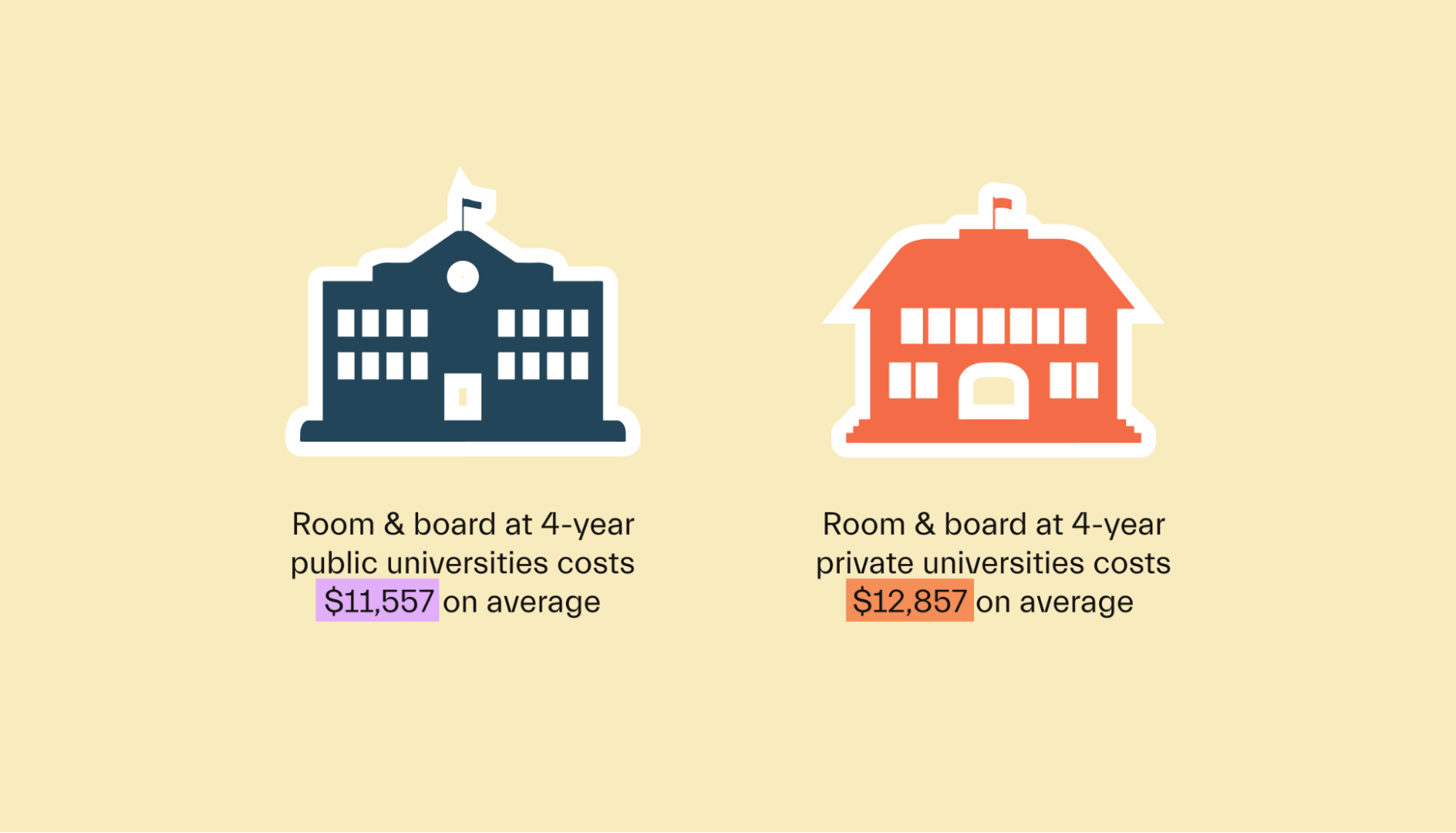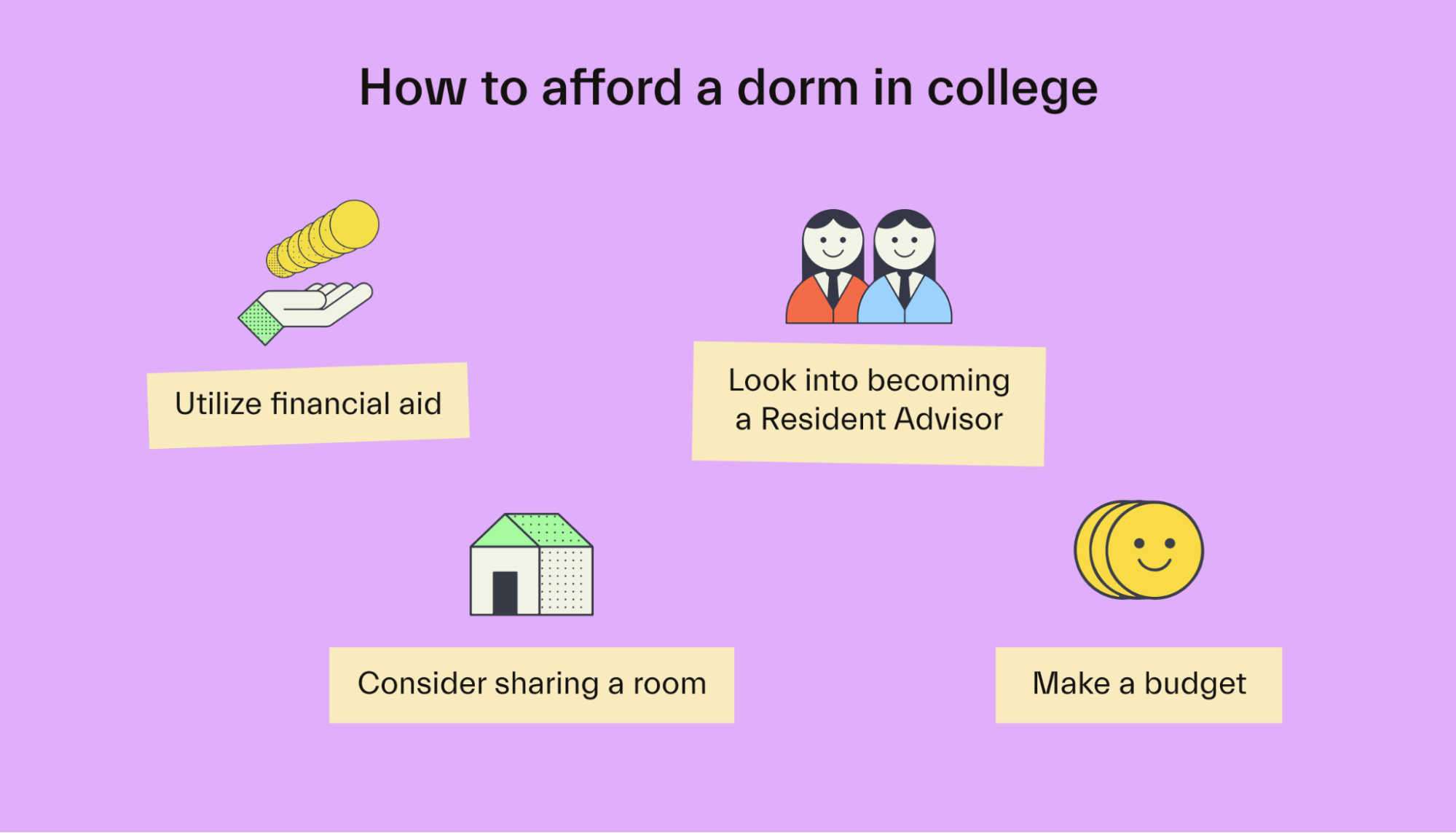Budgeting •
January 4, 2023
How much does a dorm cost?
Dorm rooms can cost anywhere from $8,000 to $15,000—or more—per year. Here’s everything you need to know about paying for your dorm.

Not to be Captain Obvious, but college is pretty dang expensive these days. How expensive? Try $35,551 per year per student, on average. Yikes!
And while tuition, books, and fees are a huge driver of the cost of college, living expenses also add up quickly. Many students choose to live in dorm rooms, which are sometimes cheaper than off-campus housing—but they still aren’t “cheap,” exactly.
So, how much does a room cost, really? Here’s what future students need to know about college dorm pricing.
How much does a dorm cost, on average?
The average dorm room costs $8,556 to $12,870 per year at 4-year institutions. At 2-year institutions, the cost range is wider at $7,111 to $11,804 per year.
At public, 4-year institutions, students pay an average of $11,557 for room and board.

Most of the time, dorm room costs also include food plans (more on this below!). This is why you often see housing costs referred to as “room and board.”
Room = lodging, and board = a meal plan.
Including food is a big perk, but there’s 1 huge downside to remember: Dorms are generally closed over the summer months and may even be closed during holiday breaks.
The rules vary depending on the school, but many schools require that students vacate the dorms during school breaks.
So, when you see that something costs $10,000 per year, what that really means is that it costs $10,000 per academic year—so around 9 months. You’ll likely be required to vacate the dorm during breaks, which means going home to see family or trying to find temporary housing.
Some schools allow students to stay in dorms during breaks or even over the summer. However, this almost always costs extra, as it’s not included in the advertised dorm room pricing.
Do dorm costs include food?
In most cases, colleges charge for “room and board,” which means housing and a meal plan. So yes, the majority of dorm room plans do include food.
In fact, most colleges require that you pay for a meal plan if you’re living on campus. The cost is generally bundled with the cost of your dorm, so you often don’t have a choice.
The details of meal plans vary, though. Some include a full 3 meals per day, while others only cover 1–2 meals per day.
Some schools require that meal plans be used in the primary dining center or cafeteria. Others provide flexible points that can be used at any food or beverage vendor on campus.
Dorm vs. off-campus housing cost comparison
So, we know that students can expect to spend between $8,556 and $12,870 for room and board while at school. That sounds expensive—but life is expensive these days!
The real question is this: How does the cost of living in a dorm compare to living off campus?

And the answer is: It depends!
While dorm rooms are often cheaper than apartments, this isn’t always the case. In fact, apartments shared with roommates can often be cheaper than dorms. But it really depends!
Comparing dorms and apartments is complicated by several factors, including the following:
Local housing costs in the area
Utility costs
Whether the student plans to have roommates
The cost of groceries in the area (and even the student’s cooking abilities!)
What the student plans to do over the summer months and during school breaks
To conceptualize this, let’s look at an example.
At a 4-year public university, the average cost of room and board is $11,557. But this only accounts for the academic year (roughly 9 months), making for an average monthly cost of $1,284.11.
In the same area, a typical small apartment costs $1,100 plus $200 worth of utilities per month, for a total of $1,300 per month. This doesn’t include food costs.
On the surface, staying in dorms makes way more financial sense. It’s about the same cost as an apartment, but it includes a meal plan.
But if the student can find a 2-bedroom apartment to share with a roommate for $1,500 per month (so $750 per person), that changes the math quite a bit.
Likewise, if the student doesn’t plan to stay with family over the summer, they may have to shell out for an expensive sublet or short-term lease. This, too, can affect the cost comparison.
Ultimately, students need to calculate the cost differences for their own situations. There’s no general rule of thumb on which is the better deal, as there are simply too many factors at play.
That said, we can dive deeper into the estimated costs of a dorm vs. an apartment to learn more.
Housing costs
The national average room and board cost at a 4-year public university is $11,557 for the ~9-month term ($1,284.11 per month).
The national average rent for a 1-bedroom apartment is $1,176 per month, plus $126 in utilities ($1,302 total).
The national average rent for a 2-bedroom apartment is $1,348 per month, plus $198 in utilities ($1,546 total, or $773 per person if shared with a roommate).
So, a typical student can expect to spend $1,284 per month for room and board if they live on campus.
To live off campus, the same student could expect to spend $1,302 per month if they live alone or $773 if they live with a roommate in a 2-bedroom apartment. Affording an apartment in college definitely becomes easier with a roommate!
The costs for the apartments listed above don’t include food, so it’s vital to account for that too.
Food costs
The USDA Thrifty Food Plan lists estimated monthly costs for a single person at between $240.50 and $308.20 per month, depending on the person’s age and gender.
This would indicate an average food cost of about $274 per month.
So, students living off campus can expect to spend around $274 per month on groceries. This doesn’t include dining out or takeout, however.

Food costs vary drastically depending on the student’s geographical area and personal preferences. Even a student’s cooking skills can affect how much food costs, so this is a tricky one to estimate!
Adding it all up
While the following costs are estimates, they are still useful for comparison purposes.
Living on campus averages $1,284.11 per month, including a food plan.
Living off campus alone (in a 1-bedroom apartment) averages $1,576 per month, including food.
Living off campus with a roommate (in a 2-bedroom apartment) averages $1,047 per month, including food.
Other considerations to make when comparing dorms and apartments
Price isn’t the only thing to consider when deciding between a dorm room and an apartment. You’ll also want to keep the following factors in mind:
Some colleges require that students live on campus—often only for the first year of school.
Dorm rooms are furnished, while most apartments are not.
Most dorm rooms are shared with 1–2 other people, so you won’t have total privacy.
Most dorm rooms have shared bathrooms.
Most apartments require a 12-month lease, while dorm rooms are typically on 9-month cycles (and exclude the summer months).
There may be additional transportation costs if you choose to live off campus.
Ultimately, each student must weigh the pros and cons to make the best decision for their needs!
How to afford a dorm in college
If this all seems quite expensive, don’t fret! There are plenty of ways to make a dorm (and other college expenses) more affordable. Here are some tips and tricks:

Utilize financial aid
Financial aid includes grants, student loans, and certain scholarships. Students can apply for financial aid by submitting the Free Application for Federal Student Aid (FAFSA) each year.
Financial aid is designed to help students pay for the cost of school—including their living expenses. It’s totally okay to use your student loans for dorm room costs or even an apartment lease.
Of course, some forms of financial aid—like grants—are essentially free money. But the bulk of financial aid for most students comes from student loans.
Student loans do need to be paid back eventually—with interest. So, paying for living expenses with loans is a tricky thing to navigate. For many students, it’s necessary, but it’s certainly worth it to consider all your options first.
Consider sharing a room
Splitting living costs with a roommate (or several) can significantly reduce the cost of housing. This is true whether you plan to live on or off campus.
We already calculated above that living alone off campus might cost around $1,576 per month, compared to around $1,047 per month if you have 1 roommate.
For on-campus housing, the difference between private and shared rooms varies significantly. Check with your school’s housing office or website to see the difference.
Look into becoming a Resident Advisor
Resident Advisors, or RAs, are students who live in dorms and help other students navigate the college experience. The college trains RAs to welcome other students to campus, show them the ropes, and help them with any issues that pop up.
RAs are often given discounted—or even free—housing in exchange for their efforts. So, by applying to be an RA in your dorm, you could save significantly on your housing costs!
Make a budget
College students are usually on a tight budget. But many don’t actually have a true budget. By being proactive with a planned-out budget, students can better manage their finances.

Budgeting involves planning out your spending for the month. It helps you get a better idea of where your money is going and what you can afford to spend on optional categories, like takeout or entertainment.
Not sure where to start with a budget? You can use one of our college student budget templates.
Bottom line
At the average 4-year university, a dorm room with a food plan costs between $8,556 and $12,870 per year. This often compares favorably to living off campus, but that really depends on the school and the local rental market.
Fortunately, students can use financial aid to cover their living costs. Other options, like bunking with roommates or becoming a resident advisor, are also worth looking into.
Want to master all aspects of your student finances? Read through the Mos blog for insights on budgeting, financial aid, scholarships, and much more.
Mos is a money app that helps students lower their tuition and earn extra cash in college.
Want to say goodbye to student debt? Check out Mos today.
Let's get
your money
- Get paired with a financial aid expert
- Get more money for school
- Get more time to do you







